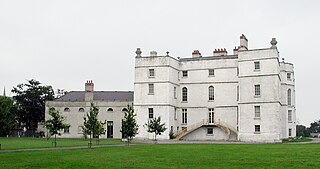Roscommon is the county town and the largest town in County Roscommon in Ireland. It is roughly in the centre of Ireland, near the meeting of the N60, N61 and N63 roads. The town is in a civil parish of the same name.

Rathfarnham Castle is a 16th-century fortified house in Rathfarnham, South Dublin, Ireland. Originally a semi-fortified and battlemented structure it underwent extensive alterations in the 18th century. It is in State care, has been restored and is open to the public.

Lough Key is a lake in Ireland. It is in the northwest of County Roscommon, northeast of the town of Boyle. The lough is believed to be named after a mythical figure named Cé.

Kiltimagh is a town in County Mayo in Ireland. As of the 2022 census, the town had a population of 1,232 people. Although there is no river going through the town, three rivers flow around the town: the Glore River, Yellow River and Pollagh River. The town centre sits at the crest of a hill surrounding The High Fort in Fortlands and built out linearly on the main road from there.
Knockcroghery is a village and townland in County Roscommon, Ireland. It is located on the N61 road between Athlone and Roscommon town, near Lough Ree on the River Shannon. The townland of Knockcroghery is in the civil parish of Killinvoy and the historical barony of Athlone North.

Frenchpark, historically known as Dungar, is a village in County Roscommon, Ireland on the N5 national primary road. It was the home of Douglas Hyde, the first President of Ireland.

Bailieborough Castle was located in Bailieborough, County Cavan, Ireland. It was built in an enclosed demesne by 1629. Also known as Castle House, Lisgar House, or simply 'The Castle', the country house was located just to the south-west of Castle Lough in what is now known as Bailieborough Demesne, on the north-western edge of the town. It was largely destroyed by fire in the early 20th century and is now totally demolished.

Lough Key Forest Park is an 800-hectare park on the southern shore of Lough Key, 40 km south east of Sligo town and 3 km east of Boyle, County Roscommon, Ireland. Formerly part of the Rockingham Estate laid out by the King family, it is open to the public.

Strokestown Park House is a Palladian style Georgian house in Strokestown, County Roscommon, Ireland, set on about 300 acres (120 ha).

Gubbarudda, formerly Gubberudda is a townland in County Roscommon, Ireland about 4.5 kilometres north-west from the village of Arigna. Gubbarudda is a very rural area composed of 432 acres with only two residences. Much of the northern parts of the townland encompasses Coillte woodlands, while its southern areas are situated on the 'Kilronan Mountain Bog Natural Heritage Area'. The population of Gubbarudda as of 2012 totaled eight people.
Garrett Dillon (c.1640-c.1696) was an Irish judge, politician and soldier, who held the office of Recorder of Dublin. He is mainly remembered today as one of the signatories of the Treaty of Limerick, which he helped to negotiate. The refusal of the Irish Parliament to ratify the Treaty led to his downfall. He fled abroad and died in exile in France.
The Crofton Family is an Anglo-Irish noble family holding titles in the Peerage of Ireland and The Baronetage of the United Kingdom.
Sir Edward Crofton, 2nd Baronet was an Irish landowner and politician, who sat in the Irish House of Commons for more than thirty years, and served briefly as a member of the Privy Council of Ireland.

Killakee House was a large Georgian house and estate near Rathfarnham in County Dublin, Ireland. It was built in c.1806 for Luke White, an Irish politician and bookseller and was the centrepiece of a 3,400-acre estate, but was demolished in 1941 after many years of vacancy.

Roebuck, also originally known as "Rabuck", is a townland and the name of a former estate in the baronies of Dublin and Rathdown in Ireland.

Kenure House was a large Georgian house and estate in Rush, County Dublin, Ireland. The main house was constructed between 1703 and 1713 by the Duke of Ormond on the grounds of an earlier house but was destroyed by fire and rebuilt around 1827. A later portico and further additions were added in 1842 to a design by George Papworth. The main house was demolished by Dublin Corporation in 1978 and the granite portico is the only portion of the main house which still stands as of 2022.

Bellamont House is a Georgian Palladian-style house set amongst 1,000 acres of grounds in Cootehill, County Cavan, Ireland. The house was completed in 1730 for Judge Thomas Coote and likely designed by his nephew, the architect Edward Lovett Pearce.

Augusta Caroline Crofton Dillon was a prolific Anglo-Irish amateur photographer and flaneur in 19th and early 20th century Ireland.

Rockingham Estate was a house and estate near Boyle, County Roscommon, Ireland covering much of the area which now makes up Lough Key Forest Park.

Gloster House is a Georgian-Palladian country house operating as a hotel and wedding venue near Brosna, County Offaly, Ireland. The design of the house has sometimes been attributed to the architect Edward Lovett Pearce who was a cousin of the owner, Trevor Lloyd, at the time the main house was constructed around 1720 – although no firm evidence of this survives.
















